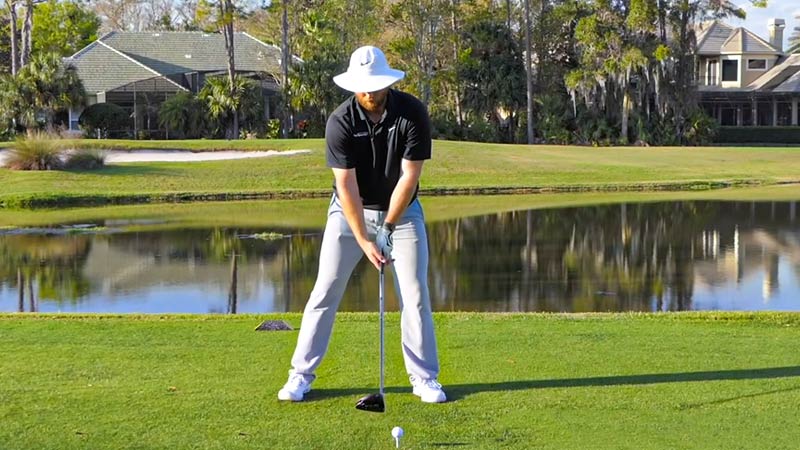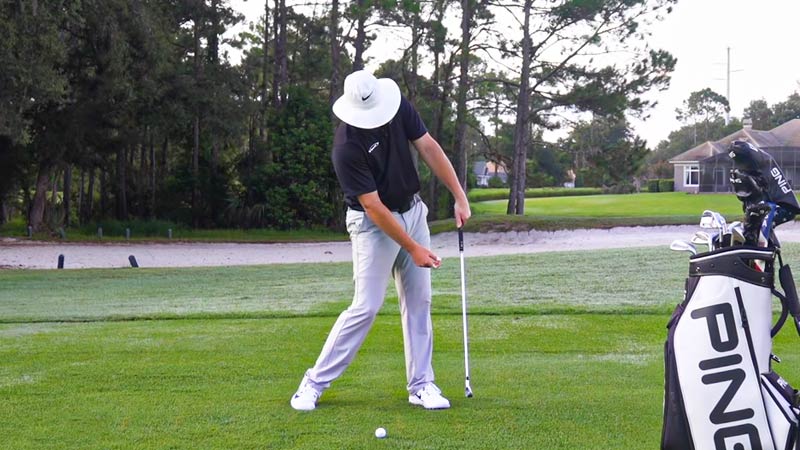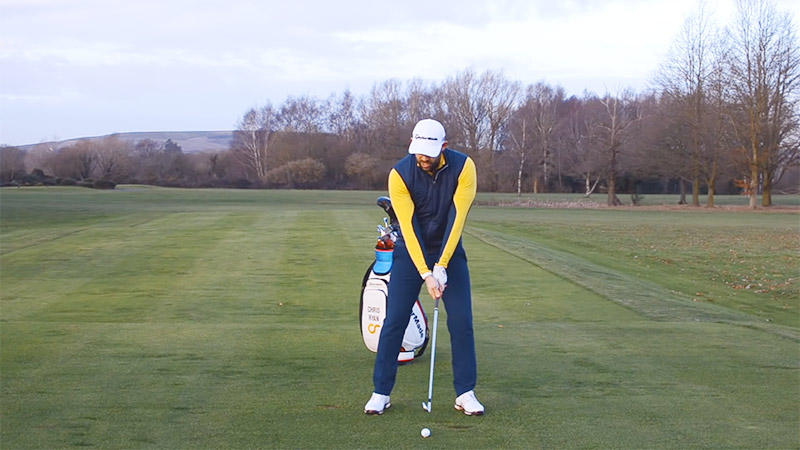The golf swing is a complex dance of precision, power, and finesse, where every subtle movement can make a significant difference in the outcome of a shot.
One of the key elements that separates great golfers from the rest is their ability to harness the concept of “lag” in their swing. Lag, often referred to as the secret sauce of the pros, holds the key to unlocking the potential for longer drives, accurate iron shots, and a more consistent overall game.
In this blog post, we delve into the intricacies of lag in the golf swing, exploring what it is, why it matters, and how you can develop it to elevate your golfing prowess. So, stay focused.
What Is Lag In Golf Swing?
Lag in a golf swing refers to the critical angle between the golfer’s wrists and the clubshaft during the downswing. It’s a fundamental aspect of an efficient swing. As a golfer transitions from the backswing to the downswing, the wrists maintain a slightly cocked position, causing the clubhead to trail behind.
This delay between the body’s rotation and the clubhead’s release creates stored energy, which is then released with precision and speed at impact, generating maximum clubhead speed and distance.
Proper lag promotes a crisp strike, control, and consistent ball striking. However, excessive or improper lag can lead to inconsistencies and mishits. Mastering the art of lag requires timing, coordination, and a comprehensive understanding of the golf swing’s mechanics.
What Creates Lag in a Golf?
Lag in a golf swing is primarily created through the sequence of movements involving the golfer’s body, arms, and wrists. Here’s how it’s generated:
Backswing
As the golfer takes the club back, their wrists hinge naturally, creating an angle between the club shaft and their lead arm (left arm for right-handed golfers). This angle stores potential energy.
Transition
During the transition from the backswing to the downswing, the lower body starts to unwind, initiating the rotation. The hips and torso begin to rotate towards the target, creating a separation between the upper and lower body.
Lag Angle Preservation
As the lower body initiates the downswing, the wrists maintain the hinged angle briefly. This preserves the lag angle, keeping the clubhead behind the hands.
Powerful Unwinding
The separation between the upper and lower body allows the golfer to unleash the stored energy in the lag angle. The clubhead starts to accelerate as it catches up with the rotating body.
Impact and Release
As the clubhead approaches the ball, the wrists start to release, unleashing the stored energy and transferring it to the ball. The hands lead the clubhead into impact, creating a powerful, accurate strike.
Creating and maintaining lag effectively requires timing, coordination, and proper sequencing of body movements. It’s crucial to initiate the downswing with the lower body, allowing the arms and club to follow suit.
Process of Creating a Lag in the Golf Swing?

Creating lag in the golf swing involves a series of coordinated movements that maximize the potential energy stored in the club shaft, leading to a powerful and controlled strike. Here’s a step-by-step process:
Address Position
Begin in a balanced stance with the ball aligned to your target. Grip the club comfortably with both hands, ensuring your lead arm (left for right-handed golfers) is relatively straight.
Takeaway
Initiate the backswing by turning your shoulders and hips while keeping your arms and wrists relatively passive. This allows the club to naturally hinge as your lead arm moves across your chest.
Wrist Hinge
As the club reaches waist-high, hinge your wrists to create an angle between the club shaft and your lead arm. This angle represents the lag you’re aiming to maintain.
Transition
As your backswing nears completion, start the downswing by rotating your hips and lower body toward the target. This rotation initiates the transfer of energy from the ground up.
Lag Preservation
Keep the angle between the club shaft and lead arm intact for a brief moment into the downswing. This delay allows the lower body’s rotation to create separation between your upper and lower body, further loading the club with energy.
Hip Rotation
As your lower body rotates, your hands and arms will naturally begin to drop, but the angle in your wrists should remain, maintaining the lag.
Unleash the Lag
At a specific point in the downswing, usually when your lead arm is parallel to the ground, start the process of releasing the stored energy. Begin by gradually uncocking your wrists, allowing the club head to catch up with the rotating body.
Impact
As the clubhead approaches the ball, the angle in your wrists should be nearly gone. Your hands will be ahead of the clubhead, leading to a crisp and powerful strike on the ball.
Follow-Through
After impact, continue the rotation of your body, allowing the club to swing naturally across your body. Your weight should transfer from your back foot to your front foot as you complete the swing.
Tips to Create a Successful Lag in Golf

Creating a successful lag in your golf swing can greatly improve your ball striking, distance, and overall swing mechanics. Here are some tips to help you develop and maintain lag effectively:
Solid Grip
Start with a proper grip. The “V” formed by your thumb and index finger of each hand should point towards your rear shoulder (right shoulder for right-handed golfers). This helps promote a natural wrist hinge during the backswing.
Wrist Hinge Awareness
Pay attention to the wrist hinge during the takeaway. Focus on allowing the wrists to hinge naturally as your arms move away from the ball. Avoid a forced or excessive hinge.
Start the Downswing with Lower Body
Initiate the downswing by rotating your hips toward the target. This hip rotation creates a kinetic chain that transfers energy from the ground up, setting the stage for proper lag.
Maintain Arm-Body Separation
As your lower body initiates the downswing, maintain the separation between your upper and lower body for a brief moment. This allows the lag angle to be preserved.
Practice Delayed Release
Work on delaying the release of the wrists as you move into the downswing. Imagine there’s a brief pause between your lower body rotation and your hands beginning to release.
Feel the Slight Tug
Focus on feeling a gentle pulling sensation in your lead arm during the downswing. This sensation indicates that you’re maintaining the lag angle between your wrists and the club shaft.
Visualize Impact Zone
Envision a point a few inches in front of the ball where you want the clubhead to strike the ground. This mental image can help you release the lag at the right moment for a crisp impact.
Gradual Wrist Release
Start releasing the lag gradually as your lead arm becomes parallel to the ground on the downswing. Feel as though your wrists are gradually uncocking, allowing the club head to catch up.
Hands Ahead at Impact
Focus on having your hands slightly ahead of the clubhead at impact. This position ensures a downward strike on the ball, promoting clean contact and preventing topped shots
Balanced Finish
After impact, allow your body to rotate fully while keeping your arms extended. A balanced finish indicates proper sequencing and a well-executed swing.
Video Analysis
Record your swing and analyze it to identify whether you’re maintaining lag effectively. Look for the angle between your lead arm and the club shaft during different phases of the swing.
Practice Patience
Developing lag takes time and practice. Be patient and persistent in your efforts to refine your swing mechanics.
Mistakes in Creating Lag
Creating lag in the golf swing can be challenging, and several common mistakes can hinder your progress. Here are some mistakes to avoid when trying to generate lag:
Overly Tight Grip
Gripping the club too tightly can restrict your wrist hinge and prevent the natural release of the club. Maintain a firm yet relaxed grip to allow for proper wrist movement.
Early Release
Releasing the wrist hinge too early in the downswing can result in a loss of power and control. Focus on delaying the release until your lead arm is parallel to the ground.
Lack of Lower Body Rotation
If your downswing is mainly driven by your arms and hands, you may not generate enough power to maintain lag. Initiate the downswing with your lower body to create the necessary kinetic chain.
Exaggerated Lag
While maintaining lag is essential, excessively holding the angle can lead to inconsistent strikes and loss of control. Strive for a balanced release that complements your swing speed.
Poor Timing
Failing to synchronize the various elements of your swing—wrist hinge, lower body rotation, and release—can lead to a breakdown in lag. Practice the correct sequence to improve your timing.
Tension in Arms and Wrists
Tensing up your arms and wrists can impede the natural movement required for lag. Stay relaxed through your arms and wrists, allowing them to move fluidly.
Inadequate Practice
Developing lag requires consistent practice and refinement. A few attempts won’t yield immediate results. Regular, deliberate practice is key to improving this aspect of your swing.
Ignoring Core Strength and Flexibility
A weak core and lack of flexibility can hinder your ability to create and maintain lag effectively. Incorporate exercises that enhance your core strength and flexibility to support your swing mechanics.
Trying to Force Lag
Forcing lag by consciously holding the angle can lead to stiffness and loss of tempo. Instead, focus on the natural sequence of movements and rhythm in your swing.
Neglecting Clubfitting
Using clubs that are ill-suited to your body type and swing mechanics can impact your ability to achieve lag. Get properly fitted clubs to optimize your swing dynamics.
Lack of Feedback
Without feedback, it’s challenging to identify the mistakes you’re making. Record your swings, review them, and consider seeking guidance from a golf instructor.
Impatience
Building a consistent golf swing with proper lag takes time. Expecting immediate results and becoming frustrated can hinder your progress. Stay patient and focused on gradual improvement.
Why Is Lag Important in Golf?
Lag is a crucial concept in golf because it directly affects the power, control, and accuracy of a golfer’s shots. Here’s why the lag is important:
Increased Clubhead Speed
Maintaining lag in the downswing allows a golfer to store potential energy in the wrist angle. Releasing this energy at the right moment results in a sudden burst of clubhead speed just before impact. This increased speed translates to greater distance on shots.
Efficient Energy Transfer
The lag angle effectively stores energy as the body unwinds during the downswing. Releasing the lag at impact ensures that this stored energy is transferred efficiently from the club to the ball, leading to a more powerful strike.
Solid Ball-Striking
Lag contributes to a consistent and solid impact with the ball. With proper lag, the clubhead descends on a slightly downward angle, promoting clean ball contact before the turf. This minimizes mis-hits and results in better ball-striking consistency.
Accuracy and Control
Lag promotes a controlled release of energy, allowing for better control over the clubface and the direction of the shot. The delayed release gives the golfer more time to square the clubface at impact, leading to straighter shots.
Prevention of Casting
Casting, or early release, is a common mistake where the wrists release too early in the downswing. This leads to a loss of power and accuracy. Developing lag helps prevent casting and promotes a more efficient sequence of movements.
Distance Gains
Generating lag enables golfers to hit the ball farther with less effort. By maximizing the speed at impact, a golfer can achieve longer distances without needing to rely solely on muscular strength.
Consistency
Lag helps build a repeatable and consistent swing. It encourages a rhythmic and coordinated sequence of movements, resulting in a more reliable swing that can be replicated across various shots.
Professional Performance
Professional golfers often demonstrate exceptional lag control, which contributes to their ability to consistently hit long, accurate shots. Amateurs can learn from these professionals and work on improving their lag to enhance their own performance.
Short Game Benefits
Lag is not only relevant for full swings but also applies to shorter shots. Maintaining a slight lag angle in chip and pitch shots allows for better control over the clubface and improved accuracy around the greens.
So, lag is the key to unlocking the potential for power and precision in a golfer’s swing. Developing and maintaining lag requires practice, proper technique, and an understanding of the mechanics involved.
FAQs
What exactly is a lag in the context of a golf swing?
Lag refers to the critical angle formed between the golfer’s wrists and the clubshaft during the downswing phase of the swing. It involves creating and maintaining a slight wrist cock, resulting in stored energy that is released at impact for added clubhead speed and distance.
Why is lag important in the golf swing?
Lag is crucial because it directly influences the power, accuracy, and control of your shots. Maintaining lag allows for efficient energy transfer, increased clubhead speed, solid ball-striking, and prevention of casting, leading to longer, more accurate shots.
How does lag contribute to better ball striking?
Lag ensures that the clubhead descends on a slightly downward angle at impact, resulting in clean ball contact before hitting the turf. This minimizes mis-hits and enhances the golfer’s ability to strike the ball consistently and accurately.
Can lag benefit short-game shots as well?
Absolutely. Lag is not limited to full swings; it also applies to shorter shots like chips and pitches. Maintaining a slight lag angle during these shots allows for better control over the clubface and improved accuracy around the greens.
Is developing lag challenging for amateur golfers?
While mastering lag requires practice and dedication, it’s attainable for golfers of all skill levels. Working on proper technique, timing, and coordination can help amateur golfers gradually improve their ability to create and maintain lag in their swings.
Wrapping Up
In the world of golf, lag is the bridge between potential and performance, separating exceptional shots from mediocre ones. As you embark on your journey to enhance your golf swing, understanding the nuances of lag and its impact is crucial.
By mastering the art of creating and maintaining lag, you’re poised to elevate your game, hit longer shots, and experience the satisfaction of cleaner ball striking.
So, step onto the course armed with the knowledge of lag, and watch as your shots gain the power, accuracy, and finesse that come with a well-executed golf swing. Thank you so much.







